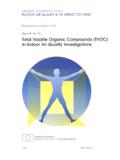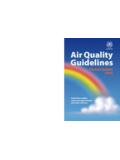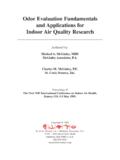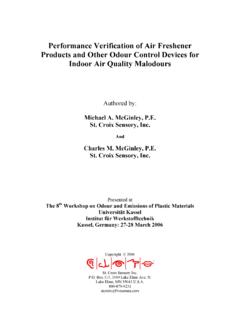Transcription of Indoor Air Quality in Buildings - City of New York
1 Indoor Air Quality in Buildings What is IAQ? IAQ stands for Indoor Air Quality . This term is used to describe the Quality of the air inside non- industrial Buildings , especially as it relates to health and comfort of building occupants. IAQ can be affected by several factors including temperature, moisture levels, carbon monoxide (CO), carbon dioxide (CO2), volatile organic compounds (VOC), particulates and microbial contaminants. What causes poor Indoor air Quality ? Common air pollutants include: CO generated by some machines as they operate both indoors and outdoors (motor vehicles, electric generators, gas powered tools).
2 Pollen Smog (a combination of smoke and fog). VOCs are chemicals that contain carbon and can be introduce into the air as gases. VOCs can be produced by some furnishings, adhesives, paints, and copiers. What causes poor Indoor air Quality ? Outdoor sources of pollution, in some cases, can affect IAQ. when they migrate indoors thru open doors and windows Microbial contaminants include molds or fungi, that can come from Indoor and outside sources Other contributors can be nuisance odors: Body odor Perfumes Air fresheners Microwave use What is ventilation? A process, whereby air is supplied and removed from an Indoor space by natural or mechanical means.
3 Why is ventilation needed indoors? To remove heat/moisture and to prevent the accumulation of Indoor pollutants. Types of Ventilation Natural (primarily used in residential). Mechanical (commercial, non-industrial Buildings ). Natural Ventilation Inflow of air: flow of outdoor air through windows, doors and a variety of openings in the Buildings . Exhausted air: movement of air from Indoor spaces to outdoors. Limitation of Natural Ventilation Fairly inefficient as it is not uniformly distributed. Air does not circulate evenly and stale air gets collected in some dead end spaces. It brings pollen and other pollutants from outside air.
4 Mechanical Ventilation Consists of fans, ductwork, heating elements/air conditioning equipment and filters Pulling fresh air from outside to Indoor spaces Exhaust stale air Control temperature and humidity inside Air Flow Inside the Buildings Air out Natural Ventilation Air flow pattern, when natural ventilation occurs Air in Stagnation zone Air flow, when uniform mixing inside (mechanical ventilation). Energy Efficiency Energy Efficiency - Starting in the 1970's the cost to heat and air condition Buildings increased dramatically. To reduce heating and air conditioning costs, Buildings were sealed-up and the amount of outside fresh air introduced into the building was drastically reduced.
5 Air Contaminants Trapped Lack of Outdoor Air ASHRAE Standard: To allow more outdoor fresh air into the building ventilation system, the American Society of Heating, Refrigeration & Air-Conditioning Engineers (ASHRAE) promulgated Standard Number , which recommends 15 to 20 cubic feet per minute (CFM) of outdoor air per person. What is a Heating Ventilation Air Conditioning (HVAC) System? The HVAC system introduces fresh air from the outdoors and uses filters to trap contaminants before re-circulating the air around the occupied spaces. Most deliver air thru vents typically placed in ceilings and walls.
6 The main function of the system is to provide thermal comfort for occupants, the HVAC also aids IAQ by helping control humidity levels indoors. Ventilation distributes the air through ducts. Heating of the air is provided with the aid of boilers or steam. Air Conditioning delivers cool air by removing excessive moisture through the use of chillers or cooling towers. HVAC Components Air Intake An opening that allows fresh air into commercial Buildings . Dampers: valve or plate that stops or regulates the flow of air inside a duct. HVAC System Components Ducts The flow of air through a duct work system HVAC System Components Filters Capture and remove particles, contaminants, vapors and gases from the air.
7 HVAC System Components Fans Aid in the circulation by the forcing the air through the ductwork system HVAC System Components Coils and Drain Pans Performs heat transfer to air when mounted inside an air handling unit or ductwork. It is heated or cooled by electrical means or by circulating liquid ] or steam within it. Cooling coils dehumidify the air and cause condensation to drip into drain pans. Drain pan collects the condensation water from the coils in the HVAC system. HVAC System Components Air Exhaust: Air is removed from a space to be recirculated or exhausted out of the building . Air Supply Vents: Air is delivered by mechanical ventilation to a space and is composed of outdoor and/or recirculated air.
8 HVAC Preventive Maintenance building Facilities should develop a preventive maintenance schedule for filter replacement. Frequent cleaning of the drain pans is essential to good Indoor air Quality . Typical HVAC System Design HVAC System HVAC ventilation systems can help with IAQ by bringing in fresh air from out side and exhaust stale air after the air is cleaned by a filtration system. Air is consistently exchanged during working hours based on type of occupancy, size of space, and number of occupants. Many HVAC units use air filters. The maintenance of the units and changing of the filters, is an essential part of making sure the HVAC works properly.
9 IAQ Guidelines The American Society of Heating, Refrigerating and Air-Conditioning Engineers (ASHRAE) sets standards for the proper operation of the HVAC system, and the concentration of oxygen and certain air pollutants that can affect IAQ. American National Standards Institute (ANSI) oversees the development of standards for products, services, processes, systems, and personnel in the United States. ANSI issues accreditation to ASRAE standards. Occupational Safety and Health Administration (OSHA)/Public Employee Safety and Health (PESH) established permissible exposure limits. ASHRAE Guidelines ASHRAE Recommended Comfort Guidelines: (ANSI/ASHRAE Standards 55-2013 and ).
10 Relative Humidity Winter Temp Summer Temp 30% F F. 40% F F. 50% F F. 60% F F. Acceptable CO2 Levels Average breathing air contains oxygen (O2). ASHRAE currently set acceptable levels of carbon monoxide at 50 parts per million (ppm) and carbon dioxide at 5000 ppm Factors Affecting IAQ. Poor Mechanical Maintenance Malfunctioning coils, including dirty coils, can waste energy and cause thermal discomfort. Standing water can accumulate if the drain pan is not properly maintained, creating a microbial habitat. Dust and dirt build-up of the duct work Factors Affecting IAQ. Blocked systems Steps for Investigating IAQ Problems Document employee complaints reported / before and during the investigation.















